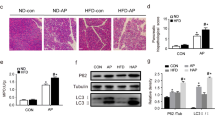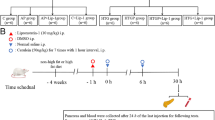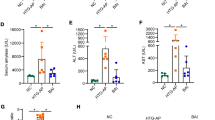Abstract
Objective
The incidence of hyperlipidemic acute pancreatitis (HLAP) has rapidly increased in recent years in China. Autophagy has been implicated in the inflammatory response of pancreatic cells in HLAP, but the molecular mechanisms remain unclear.
Methods
In this study, the role of HIF-1α–PPARγ–mTORC1 pathway-mediated autophagy in the inflammatory response of pancreatic cells and the underlying molecular mechanism were investigated in a rat model of HLAP using immunohistochemistry, ELISA, electron microscopy, and western blot analysis.
Results
The results revealed that autophagy was significantly increased and pancreatic injury was exacerbated in HLAP rats, and the inflammatory response was further exacerbated by treatment with rapamycin but relieved by treatment with 3-MA. Hyperlipidemia induced upregulation of HIF-1α and downregulation of PPARγ, which in turn led to an increase in autophagy and consequently exacerbation of the inflammatory response of pancreatic cells.
Conclusions
HIF-1α–PPARγ–mTORC1 pathway-mediated autophagy plays a critical role in the inflammatory response of pancreatic cells in HLAP, and interference with the HIF-1α–PPARγ–mTOR pathway can serve as a new strategy for the prevention and treatment of HLAP.




Similar content being viewed by others
Data availability
The dataset supporting the conclusions of this article are included within the article.
Abbreviations
- HLAP:
-
Hyperlipidemic acute pancreatitis
- HIF-1α:
-
Hypoxia-inducible factor 1-alpha
- mTORC1:
-
Mammalian Target of Rapamycin Complex 1
- PPARγ:
-
Peroxisome proliferator-activated receptor-γ
- Beclin-1:
-
Myosin-like BCL-2 interacting protein
- LC3-II:
-
Microtubule-associated protein light chain 3-II
- siRNA:
-
Small Interfering Ribonucleic Acid
- 3-MA:
-
3-methyladenine
- TG:
-
Triglyceride
- TC:
-
Total cholesterol
- AMY:
-
Amylase
- LPS:
-
Lipase
- TNF-α:
-
Tumor necrosis factor-α
- PI3K:
-
Phosphatidylinositol 3-kinase
- Akt:
-
Protein kinase B
- ROS:
-
Reactive oxygen species
- ATG:
-
Autophagy related gene
References
Huang YX, Jia L, Jiang SM et al (2014) Incidence and clinical features of hyperlipidemic acute pancreatitis from Guangdong, China: a retrospective multicenter study. Pancreas 43:548–552. https://doi.org/10.1097/mpa.0000000000000069
Sorice M (2022) Crosstalk of Autophagy and Apoptosis[J]. Cells. https://doi.org/10.3390/cells11091479
Gukovskaya AS, Gukovsky I, Algul H et al (2017) Autophagy, inflammation, and Immune Dysfunction in the pathogenesis of Pancreatitis[J]. Gastroenterology 153(5):1212–1226. https://doi.org/10.1053/j.gastro.2017.08.071
Noguchi M, Hirata N, Tanaka T et al (2020) Autophagy as a modulator of cell death machinery[J]. Cell Death Dis 11(7):517. https://doi.org/10.1038/s41419-020-2724-5
Levine B, Yuan J (2005) Autophagy in cell death: an innocent convict? J Clin Investig 115:2679–2688. https://doi.org/10.1172/jci26390
Ohmuraya M, Yamamura K (2008) Autophagy and acute pancreatitis: a novel autophagy theory for trypsinogen activation. Autophagy 4:1060–1062. https://doi.org/10.4161/auto.6825
Gukovsky I, Gukovskaya AS (2010) Impaired autophagy underlies key pathological responses of acute pancreatitis. Autophagy 6:428–429. https://doi.org/10.4161/auto.6.3.11530
Fortunato F, Kroemer G (2009) Impaired autophagosome-lysosome fusion in the pathogenesis of pancreatitis. Autophagy 5:850–853. https://doi.org/10.4161/auto.8839
Mizushima N, Levine B, Cuervo AM et al (2008) Autophagy fights disease through cellular self-digestion. Nature 451:1069–1075. https://doi.org/10.1038/nature06639
Xu B, Bai B, Sha S et al (2014) Interleukin-1beta induces autophagy by affecting calcium homeostasis and trypsinogen activation in pancreatic acinar cells. Int J Clin Exp Pathol 7:3620–3631
Song Z, Huang Y, Liu C et al (2018) miR-352 participates in the regulation of trypsinogen activation in pancreatic acinar cells by influencing the function of autophagic lysosomes. Oncotarget 9:10868–10879. https://doi.org/10.18632/oncotarget.24220
Liu MW, Wei R, Su MX et al (2018) Effects of Panax notoginseng saponins on severe acute pancreatitis through the regulation of mTOR/Akt and caspase-3 signaling pathway by upregulating miR-181b expression in rats. BMC Complement Altern Med 18:51. https://doi.org/10.1186/s12906-018-2118-8
Zhu ZD, Yu T, Liu HJ et al (2018) SOCE induced calcium overload regulates autophagy in acute pancreatitis via calcineurin activation. Cell Death Dis 9. https://doi.org/10.1038/s41419-017-0073-9
Biczo G, Vegh ET, Shalbueva N et al (2018) Mitochondrial dysfunction, through impaired autophagy, leads to endoplasmic reticulum stress, deregulated lipid metabolism, and pancreatitis in animal models. Gastroenterology 154:689–703. https://doi.org/10.1053/j.gastro.2017.10.012
Dolai S, Liang T, Orabi AI et al (2018) Pancreatitis-Induced Depletion of Syntaxin 2 promotes autophagy and increases basolateral exocytosis. Gastroenterology 154:1805–1821. https://doi.org/10.1053/j.gastro.2018.01.025
Ji L, Li L, Qu F et al (2016) Hydrogen sulphide exacerbates acute pancreatitis by over-activating autophagy via AMPK/mTOR pathway. J Cell Mol Med 20:2349–2361. https://doi.org/10.1111/jcmm.12928
Sun L, Zhang S, Yu C et al (2015) Hydrogen sulfide reduces serum triglyceride by activating liver autophagy via the AMPK-mTOR pathway. Am J Physiol Endocrinol metabolism 309:925–935. https://doi.org/10.1152/ajpendo.00294.2015
Mei Q, Zeng Y, Huang C et al (2020) Rapamycin alleviates hypertriglyceridemia-related Acute Pancreatitis via restoring autophagy flux and inhibiting endoplasmic reticulum stress. Inflammation 43:1510–1523. https://doi.org/10.1007/s10753-020-01228-7
Levine B, Mizushima N, Virgin HW (2011) Autophagy in immunity and inflammation. Nature 469:323–335. https://doi.org/10.1038/nature09782
Xiao H, Gu Z, Wang G et al (2013) The possible mechanisms underlying the impairment of HIF-1alpha pathway signaling in hyperglycemia and the beneficial effects of certain therapies. Int J Med Sci 10:1412–1421. https://doi.org/10.7150/ijms.5630
Choi H, Merceron C, Mangiavini L et al (2016) Hypoxia promotes noncanonical autophagy in nucleus pulposus cells independent of MTOR and HIF1A signaling. Autophagy 12:1631–1646. https://doi.org/10.1080/15548627.2016.1192753
Warbrick I, Rabkin SW (2019) Hypoxia-inducible factor 1-alpha (HIF-1alpha) as a factor mediating the relationship between obesity and heart failure with preserved ejection fraction. Obes reviews: official J Int Association Study Obes 20:701–712. https://doi.org/10.1111/obr.12828
Ji L, Guo X, Lv J et al (2019) Hypoxia-inducible Factor-1alpha Knockdown Plus glutamine supplementation attenuates the predominance of necrosis over apoptosis by relieving Cellular Energy stress in Acute Pancreatitis. Oxidative Med Cell Longev. https://doi.org/10.1155/2019/4363672
Li HH, Tyburski JB, Wang YW et al (2014) Modulation of fatty acid and bile acid metabolism by peroxisome proliferator-activated receptor alpha protects against alcoholic liver disease. Alcohol Clin Exp Res 38:1520–1531. https://doi.org/10.1111/acer.12424
Niyaz B, Zhao KL, Liu LM et al (2013) Rosiglitazone attenuates the severity of hyperlipidemic severe acute pancreatitis in rats. Experimental and therapeutic medicine 6:989–994. https://doi.org/10.3892/etm.2013.1255
Feng P, Xu Y, Tong B et al (2020) Saikosaponin a attenuates hyperlipidemic pancreatitis in rats via the PPAR-gamma/NF-kappaB signaling pathway. Experimental and therapeutic medicine 19:1203–1212. https://doi.org/10.3892/etm.2019.8324
Li D, Du Y, Yuan X et al (2017) Hepatic hypoxia-inducible factors inhibit PPARα expression to exacerbate acetaminophen induced oxidative stress and hepatotoxicity. Free Radic Biol Med 110:102–116. https://doi.org/10.1016/j.freeradbiomed.2017.06.002
He Y, Yang W, Gan L et al (2021) Silencing HIF-1α aggravates non-alcoholic fatty liver disease in vitro through inhibiting PPAR-α/ANGPTL4 singling pathway. Gastroenterol Hepatol 44:355–365. https://doi.org/10.1016/j.gastrohep.2020.09.014
Li X, Zhang Y, Zhang B et al (2018) HIF-1alpha-l-PGDS-PPARgamma regulates hypoxia-induced ANP secretion in beating rat atria. Prostaglandins Other Lipid mediat 134:38–46. https://doi.org/10.1016/j.prostaglandins.2017.12.001
Zhao YZ, Liu XL, Shen GM et al (2014) Hypoxia induces peroxisome proliferator-activated receptor gamma expression via HIF-1-dependent mechanisms in HepG2 cell line. Arch Biochem Biophys 543:40–47. https://doi.org/10.1016/j.abb.2013.12.010
Vasheghani F, Zhang Y, Li YH et al (2015) PPARgamma deficiency results in severe, accelerated osteoarthritis associated with aberrant mTOR signalling in the articular cartilage. Ann Rheum Dis 74:569–578. https://doi.org/10.1136/annrheumdis-2014-205743
Li BH, Liao SQ, Yin YW et al (2015) Telmisartan-induced PPARgamma activity attenuates lipid accumulation in VSMCs via induction of autophagy. Mol Biol Rep 42:179–186. https://doi.org/10.1007/s11033-014-3757-6
Acknowledgements
We thank National Natural Sciences Foundation of China ,Innovative and Entrepreneurial Doctor Program of Jiangsu Provincial, Top Talents Support Program for young and middle-aged people of Wuxi Health committee and The Scientific Research Project of Wuxi Health committee for their fnancial support.We thank LetPub (www.letpub.com) for its linguistic assistance during the preparation of this manuscript.
Funding
This work was supported by the National Natural Science Foundations of China (No. 81760334), Innovative and Entrepreneurial Doctor Program of Jiangsu Provincial, Top Talents Support Program for young and middle-aged people of Wuxi Health committee and The Scientific Research Project of Wuxi Health committee (Youth Project, No.Q201912).
Author information
Authors and Affiliations
Contributions
MYM and LXL contributed to the conception and design of the study, acquired the majority of the data, and drafted the manuscript.LZL contributed to the conception and design of the study and acquired some of the data. XXH contributed to the design of the study and interpretation of the data.WYP and MYC contributed to the design of the study, and interpretation of data, and substantively revised the manuscript. All the authors reviewed and approved the final draft of the manuscript.
Corresponding author
Ethics declarations
Ethical approval and consent to participate
This study was conducted in accordance with the guidelines of the Declaration of Helsinki. All animal experimental protocols applied in this study were conducted in accordance with the standards of the Animal Ethics Committee of Huishan District People’s Hospital of Wuxi City, China.
Competing Interests
The authors declare no competing interests.
Additional information
Yumei Ma and Xiaolin Li contributed equally to this work.
Publisher’s Note
Springer Nature remains neutral with regard to jurisdictional claims in published maps and institutional affiliations.
Rights and permissions
Springer Nature or its licensor (e.g. a society or other partner) holds exclusive rights to this article under a publishing agreement with the author(s) or other rightsholder(s); author self-archiving of the accepted manuscript version of this article is solely governed by the terms of such publishing agreement and applicable law.
About this article
Cite this article
Ma, Y., Li, X., Liu, Z. et al. HIF-1α–PPARγ–mTORC1 signaling pathway-mediated autophagy induces inflammatory response in pancreatic cells in rats with hyperlipidemic acute pancreatitis. Mol Biol Rep 50, 8497–8507 (2023). https://doi.org/10.1007/s11033-023-08639-3
Received:
Accepted:
Published:
Issue Date:
DOI: https://doi.org/10.1007/s11033-023-08639-3




